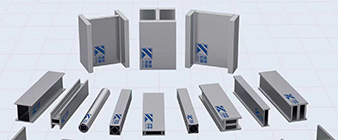- Heavy road vehicles: chassis, dumper bodies.
- Cranes construction: booms of mobile cranes. Structural.
- steelworks: bridges, bridge components, components for offshore structures.
- Pressure vessels: fixed and transportable storage tanks, vessels.
- Power plants: penstocks, spiral cases.
- Materials handling: lifting and mobile.
- equipment. Mining and earthmoving equipment: roof supports. Agricultural equipment and trailers.
| C | Si | Mn | P | S | Cr | Mo | Ni | Al |
|---|---|---|---|---|---|---|---|---|
| ≤0.2 | ≤0.8 | ≤1.70 | ≤0.020 | ≤0.005 | ≤1.50 | ≤0.70 | ≤2.0 | ≤0.100 |
| Plate Thickness mm |
Yield Point Re MPa |
Tensile Strength Rm MPa |
Elongation at Rupture A5 % |
|---|---|---|---|
| ≤ 50 | 690 | 770 – 940 | 14 |
| > 50 ≤ 100 | 650 | 760 – 930 | 14 |
| > 100 ≤ 150 | 630 | 710 – 900 | 14 |
| Steel Grade | Position of Samples | 0°C | -20°C | -40°C | -60°C |
|---|---|---|---|---|---|
| S690Q | Longitudinal | 40 J | 30 J | – | – |
| Transverse | 30 J | 27 J | – | – | |
| S690QL | Longitudinal | 50 J | 40 J | 30 J | – |
| Transverse | 35 J | 30 J | 27 J | – | |
| S690QL1 | Longitudinal | 60 J | 50 J | 40 J | 30 J |
| Transverse | 40 J | 35 J | 30 J | 27 J |
Tensile test and impact test (3 samples) every 40 t or per heat treatment unit respectively.
The steel is suitable for cold-forming adhering to a bending or folding radius of > 4 times plate thickness longitudinal and > 3 times plate thickness transverse to rolling direction. A subsequent stress relief annealing is possible up to a temperature of 580°C.
Hot-forming above 580°C is possible. A subsequent quenching and tempering has to be carried out according to the delivery condition.
Drilling with cobalt-alloyed high-speed steels HSSCO, the cutting speed should be approximately 17 – 19 m/min. If HSS drills are used, it should be approximately 3 – 5 m/min. cutting speed should be approximately 3 – 5 m/min.
The material temperature should be at least room temperature. We recommended the following preheating temperatures: for plate thicknesses > 40mm up to 100°C, > 80mm up to 150°C and > 100mm up to 175°C.
The steel is suitable for all known welding methods. The material temperature should be at least room temperature. We recommended the following preheating temperatures: for plate thicknesses > 20mm up to 75°C, > 40mm up to 100°C, > 60mm up to 150°C and > 100mm up to 175°C. Interpass temperature should be between 150°C – 225°C.
-
 2024-1-02 Structural steel properties and applications
2024-1-02 Structural steel properties and applications -
 2024-9-29 Nickel Alloy C4 / 2.4610 Nickel alloy structural profiles
2024-9-29 Nickel Alloy C4 / 2.4610 Nickel alloy structural profiles -
 2024-9-24 EN standard 1.4401 stainless steel structural hollow Sections
2024-9-24 EN standard 1.4401 stainless steel structural hollow Sections -
 2024-9-16 What are the common applications of 2205 duplex stainless steel?
2024-9-16 What are the common applications of 2205 duplex stainless steel? -
 2024-9-27 318LN Stainless Steel Structural Beams and Columns
2024-9-27 318LN Stainless Steel Structural Beams and Columns -
 2024-9-25 UNS N08926 Super Stainless Steel Structural Profiles
2024-9-25 UNS N08926 Super Stainless Steel Structural Profiles -
 2024-9-15 EN 1.4301 / 304 / 1.4307 / 304L performance and advantages
2024-9-15 EN 1.4301 / 304 / 1.4307 / 304L performance and advantages



